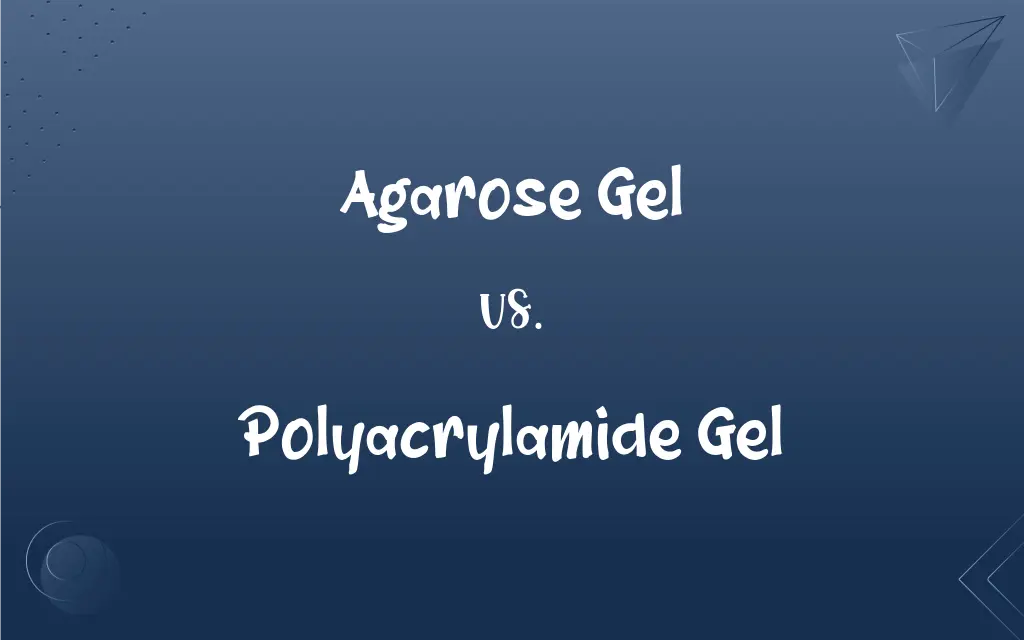Agarose Gel vs. Polyacrylamide Gel: What's the Difference?
Edited by Aimie Carlson || By Janet White || Published on February 11, 2024
Agarose gel, used for DNA/RNA separation, has larger pores; polyacrylamide gel, with smaller pores, is used for proteins and smaller nucleic acids.

Key Differences
Agarose gels are typically used in DNA and RNA electrophoresis due to their larger pore size. Polyacrylamide gels are preferred for protein electrophoresis and smaller nucleic acids, owing to their finer pore structure. This fundamental difference in pore size affects their respective uses in molecular biology.
Agarose gels are made from the polysaccharide agarose, derived from seaweed. They are easier to prepare and handle. Polyacrylamide gels are synthesized from acrylamide monomers and a cross-linker, requiring more careful preparation due to the toxicity of unpolymerized acrylamide.
The resolving power of agarose gels is lower, making them suitable for larger molecules. In contrast, polyacrylamide gels offer higher resolution, ideal for separating molecules with small differences in size.
Agarose gels are less dense and more fragile, often used for DNA fragments from 100 base pairs to several kilobases. Polyacrylamide gels are denser and more robust, suitable for fragments as small as a single base pair.
The flexibility in manipulating the pore size is greater in polyacrylamide gels by varying the acrylamide concentration. Agarose gels offer a narrower range of pore size adjustments, typically controlled by the concentration of agarose.
ADVERTISEMENT
Comparison Chart
Pore Size
Larger pores
Smaller pores
Composition
Polysaccharide agarose
Acrylamide monomers and cross-linker
Use
DNA/RNA electrophoresis
Protein electrophoresis, small nucleic acids
Resolution
Lower, for larger molecules
Higher, for molecules with small size differences
Flexibility and Durability
Less flexible, more fragile
More flexible, more durable
ADVERTISEMENT
Agarose Gel and Polyacrylamide Gel Definitions
Agarose Gel
A laboratory tool for analyzing large pieces of DNA or RNA.
Agarose gel electrophoresis is a key step in cloning experiments.
Polyacrylamide Gel
A gel used in protein electrophoresis and DNA sequencing.
Proteins were separated based on size using a polyacrylamide gel.
Agarose Gel
A gelatinous substance allowing the separation of large DNA molecules.
Researchers used agarose gel to visualize the DNA samples.
Polyacrylamide Gel
A finer matrix for separating small biomolecules.
The polyacrylamide gel allowed for detailed analysis of protein fragments.
Agarose Gel
A gel used for DNA and RNA separation in electrophoresis.
The DNA fragments were separated using an agarose gel.
Polyacrylamide Gel
A gel offering high resolution in molecular biology experiments.
The polyacrylamide gel provided clear distinction between closely sized DNA fragments.
Agarose Gel
A medium for nucleic acid electrophoresis with large pore size.
The agarose gel provided clear separation of the RNA bands.
Polyacrylamide Gel
A laboratory tool made from acrylamide, used in biochemical analysis.
Scientists used a polyacrylamide gel to study the DNA-protein interaction.
Agarose Gel
A matrix derived from seaweed used in molecular biology.
Agarose gel is commonly used in labs for gene analysis.
Polyacrylamide Gel
A dense, robust gel for detailed electrophoretic applications.
The research team employed a polyacrylamide gel to identify mutations in a gene.
FAQs
What determines the pore size in agarose gel?
The pore size in agarose gel is determined by the concentration of agarose used.
Is polyacrylamide gel toxic?
Yes, unpolymerized acrylamide, used to make polyacrylamide gel, is toxic and requires careful handling.
What is agarose gel primarily used for?
Agarose gel is used for separating and analyzing larger DNA or RNA molecules.
What is the main use of polyacrylamide gel?
Polyacrylamide gel is used for protein electrophoresis and analyzing smaller nucleic acids.
Are agarose gels reusable?
Agarose gels are typically not reused due to the risk of contamination and degradation.
Can agarose gel be used for protein analysis?
Agarose gel is not typically used for protein analysis due to its larger pore size.
How is the pore size in polyacrylamide gel controlled?
The pore size in polyacrylamide gel is controlled by varying the concentration of acrylamide.
Can polyacrylamide gels resolve single-base pair differences?
Yes, polyacrylamide gels can resolve differences as small as a single base pair.
What is the source of agarose in agarose gels?
Agarose is derived from seaweed.
Is specialized equipment needed for polyacrylamide gel electrophoresis?
Yes, electrophoresis apparatus and power supply are needed for polyacrylamide gel electrophoresis.
Can agarose gels differentiate small DNA fragments?
Agarose gels are less effective for very small fragments; polyacrylamide gels are better suited for this.
How does gel concentration affect electrophoresis in agarose?
Higher concentrations of agarose create smaller pores, suitable for smaller DNA fragments.
Can polyacrylamide gel electrophoresis separate different protein sizes?
Yes, polyacrylamide gel electrophoresis can separate proteins of different sizes effectively.
What safety precautions are necessary when using polyacrylamide gels?
Protective gear and proper ventilation are necessary due to the toxicity of acrylamide.
How long can agarose gels be stored before use?
Agarose gels should be used soon after preparation; long-term storage is not recommended.
What is the resolution limit of polyacrylamide gels?
Polyacrylamide gels can resolve molecules with very small size differences, even single nucleotides.
Can polyacrylamide gels be used for large DNA fragments?
Polyacrylamide gels are not ideal for large DNA fragments due to their smaller pore size.
Are there alternatives to polyacrylamide gels for protein analysis?
Yes, there are other methods like capillary electrophoresis, but polyacrylamide gels are widely used.
Is there a risk of DNA damage when using agarose gels?
There is minimal risk of DNA damage when using agarose gels under proper conditions.
How is the gel strength of agarose gels adjusted?
The gel strength of agarose gels is adjusted by changing the agarose concentration.
About Author
Written by
Janet WhiteJanet White has been an esteemed writer and blogger for Difference Wiki. Holding a Master's degree in Science and Medical Journalism from the prestigious Boston University, she has consistently demonstrated her expertise and passion for her field. When she's not immersed in her work, Janet relishes her time exercising, delving into a good book, and cherishing moments with friends and family.
Edited by
Aimie CarlsonAimie Carlson, holding a master's degree in English literature, is a fervent English language enthusiast. She lends her writing talents to Difference Wiki, a prominent website that specializes in comparisons, offering readers insightful analyses that both captivate and inform.







































































